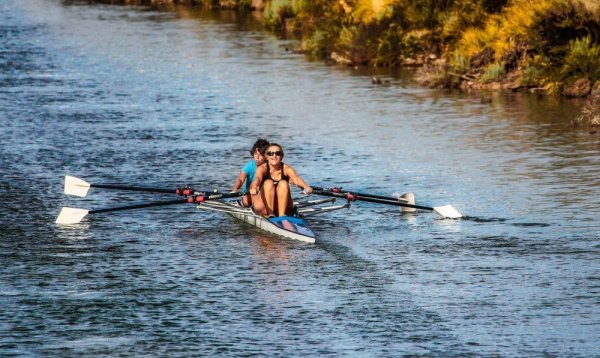yogabook / movement physiology / rowing

A form of locomotion documented in Egypt as early as 7000 years ago, in which oars held in the hands are cyclically immersed in the water, pulled dorsally against the water resistance using the strength of the arms and legs and then lifted out of the water again to be immersed again further forwards. In order to utilise the strength of the legs in addition to the strength of the upper extremities and the trunk muscles that move them, the rowers (or one rower) are pulled towards the body at the same time (movement primarily from the strength of the arm flexors, of the latissimus dorsi and other adductors of the shoulder joint such as the teres major and teres minor), a sled on rollers is pushed backwards using the strength of the legs, whereby a lot of strength from larger muscle groups such as the knee extensor quadriceps and the hip extensors can be utilised. The movement of the arms is primarily a transverse abduction of the arms into retroversion. The back must be kept straight during exercise so that it and the intervertebral discs in the spine are not damaged.
Rowing is considered to be a relatively low-risk endurance sport with relatively few side effects, which primarily trains strength endurance. The existing risks include problems in the caudal region of the thoracolumbar transition such as disc problems, spondylolisthesis or osteochondrosis, SIJ blockages or, in adolescence, Scheuerman’s disease. The less mobile the hip extensors are, i.e. primarily the hamstrings, the more likely it is that these problems will occur, followed by other hip muscles such as the gluteus maximus, as their shortening tilts the pelvis backwards at the top and forces flexion of the lumbar spine. When rowing with straps (both hands on one oar), large torques also occur in the upper body, which also puts strain on the lumbar spine in particular. Cold and wet weather is also a risk factor for the musculoskeletal system, especially for the joints. The knee joints can be affected by PFPS (patellofemoral pain syndrome), which can also be caused by concomitant strength training. Misalignments of the patella, knock knees and bow legs predispose to this. ITBS (iliotibial band syndrome, „runner’s knee“) is also possible due to the iterated flexion and extension movements in the knee joint under heavy load. In the upper extremity, tendovaginitis of the wrist dorsiflexors mainly occurs if the technique is not correct (rotation of the blade), cold and wet conditions predispose to it, as does the start of the season with the change from indoor to outdoor training. The iterated palmar flexion that occurs under load predisposes to carpal tunnel syndrome and also to tendovaginitis. In general, muscular shortening occurs, particularly in the executive muscles, but also more frequently in the hip flexors.
In the area of asana, the above can be supported with postures to promote the
- Strength of the autochthonous back muscles (back health) in the lumbar spine area: effect no. 642 and in general: effect no. 602
- Strength of the short hip extensors (to increase performance): effect no. 727
- Power of the hamstrings (to increase performance): effect no. 722
- Flexibility of the hamstrings (back health): effect no. 721
- Ability to stretch the short hip extensors (back health): effect no. 726
- Strength of the finger flexors and wrist palmar flexors (increased performance, injury prevention): effect no. 422
- Flexibility of the finger flexors and wrist palmar flexors (injury prevention): effect no. 421
- Strength of the finger extensors and wrist dorsiflexors (injury prevention): effect no. 427
- flexibility of the finger extensors and wrist dorsiflexors (injury prevention): effect no. 426
